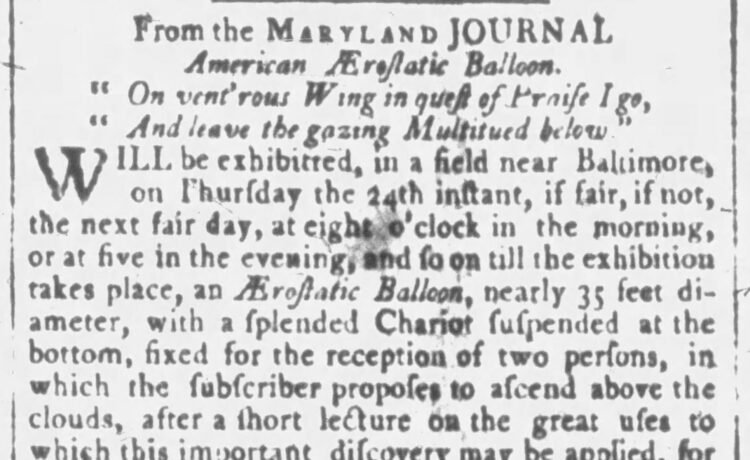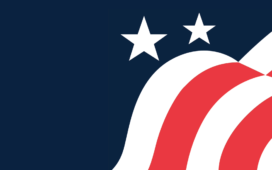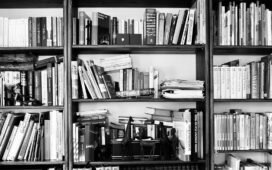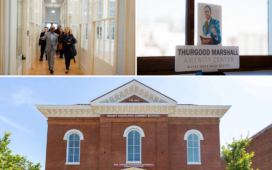By Lara Westwood, Librarian
Maryland has always been at the forefront of aviation history. Would-be pilots experimented with flying machines, such as hot air balloons and dirigibles, before the first airplanes were built by homegrown inventors and daredevils invigorated by the Wright brothers’ achievement at Kitty Hawk, North Carolina. Today, the aviation and aeronautics industries remain a significant part of the state’s heritage.
Peter Carnes, a lawyer and owner of the Indian Queen Tavern (PG:69-2) in Bladensburg, orchestrated the first manned flight in the United States in 1784. Inspired by the Montgolfier brothers’ successful hot air balloon flights in France, Carnes seized the chance to capitalize on the “Balloon Mania” sweeping Europe and spreading to America. He built his own balloon despite lacking any formal training and began selling tickets to watch the balloon ascend over Bladensburg. During his first show on June 17, he had intended to ride in the basket, but it was broken in transit, so he could not ride. Later that month, he moved his show to Baltimore with plans to ascend in his balloon, but realizing he was too heavy, he found a volunteer to fly in his stead. On June 24, Edward Warren, just 13 years old, became the first person to man an aircraft in the country. Carnes attempted ascension in his balloon in Philadelphia month later, but a strong wind broke the chains of the basket. He fell to the ground, and the balloon caught fire, which led many spectators to believe he had met his demise. Carnes decided to give up ballooning after this brush with death. These early balloon ascents sparked a series of hot air balloon exhibitions and inspired attempts to build improved balloons. Hot air balloons were even used in the Civil War.

As hot air balloons were largely impractical for transportation, aeronauts and inventors turned to building heavier-than-air flying machines. After years of experimentation, Wilbur and Orville Wright had their first successful airplane flight in 1903. Recognizing the significance of this achievement, the United States Army established an aeronautical division in 1907 and soon hired the Wright brothers to build planes. They were brought to a brand-new airfield at College Park to train pilots. These pilots flew the first airplane owned by the American government, which took flight from the College Park Airport (PG:66-4) on October 8, 1909. The airport became the site of many aviation firsts, including the first female passenger, the first night landing, and the first airmail route. The Army Signal Corps operated an aviation school there from 1911 to 1913. After the aviation school closed, the airport was used for civilian aviation pursuits. The College Park Airport is now the oldest, continuously operating airport in the world and a museum was opened at the site in 1981.
In the 1910s and 1920s, airfields and airports sprang up across Maryland to accommodate civilian pilots. Amateur aviators across the country constructed their own planes or purchased them from emerging aircraft manufacturers, while aviation clubs and schools trained new pilots and improved airplane design. Air shows and competitions showcased the daring skills of these aviators. Meanwhile, the United States Army and Navy established airports and testing facilities, such as the Naval Aviation Camp at Greenbury Point in Annapolis.

Aircraft technology rapidly evolved from the relatively simple machines built by the Wright brothers. The commercial and military potential of air travel led to an explosion in the industry. The Glenn L. Martin Company opened two aircraft manufacturing plants and an airport (BA-2081) in Baltimore County. The first plant (BA-3152) opened in 1929 and by 1940 employed over 10,000 people. The second plant (BA-2824) was purpose-built to churn out B-26 Marauder Medium Bombers needed to equip Allied air forces during World War II. Other manufacturers, such as Berliner-Joyce and Curtiss-Caproni, opened plants in the state, but both struggled during the Great Depression. Maryland is also home to aeronautical research facilities, such as the Goddard Space Flight Center (PG:64-6) in Greenbelt and the Johns Hopkins University Applied Physics Laboratory in Laurel.
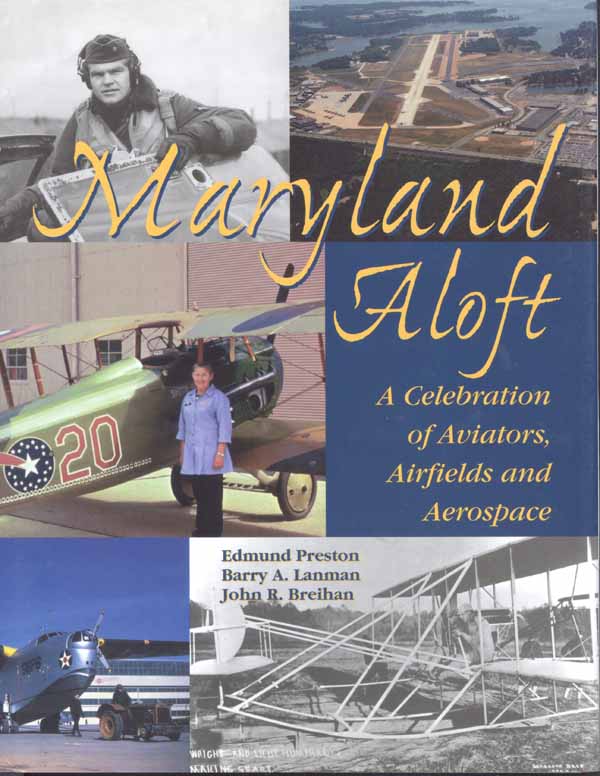
As air travel expanded, several municipal and private airports were opened to meet growing demand. Logan Field in Dundalk was Baltimore’s first municipal airport, established in 1919 to support the local air club. In 1930, it began offering scheduled passenger flights via Eastern Air Transport, but demand quickly outgrew the airfield and it was replaced by the Baltimore Municipal Airport (BA-2094). Within a few years, the city again needed a larger airport. An over 3,000-acre tract near Linthicum Heights (Anne Arundel County) was chosen, and Friendship International Airport (AA-30) – now known as the Baltimore/Washington International Thurgood Marshall Airport – was dedicated in 1950. Today, it remains the state’s largest airport and has undergone numerous renovations and expansions over the years.
Marylanders have made significant contributions to aviation, and the historic sites enumerated here are just a few of the many places in the state important to the history of flight. To learn more about Maryland’s aviation history, check out the Maryland Historical Press publication, Maryland Aloft: A Celebration of Aviators, Airfields and Aerospace by Edmund Preston, Barry A. Lanman, and John R. Breihan (2003), now on sale for 50% off on our website.
References and works cited:
Beckwith, Alison. 2020. “Bladensburg: Birthplace of U.S. Hot Air Balloons.” Hyattsville Wire. January 23, 2020.
Elevado, Megan. 2014. “Balloon Mania.” Cooper Hewitt Smithsonian Design Museum. August 13, 2014.
Maryland Aviation Administration. 2024. “Maryland Aviation History.” July 9, 2024. .
Preston, Edmund, Barry Allen Lanman, and John R. Breihan. 2003. Maryland Aloft: A Celebration of Aviators, Airfields, and Aerospace.
Vobejda, Barbara. 1984. “‘Father of U.S. Ballooning’ Feted.” Washington Post, June 16, 1984.
Discover more from Our History, Our Heritage
Subscribe to get the latest posts sent to your email.

